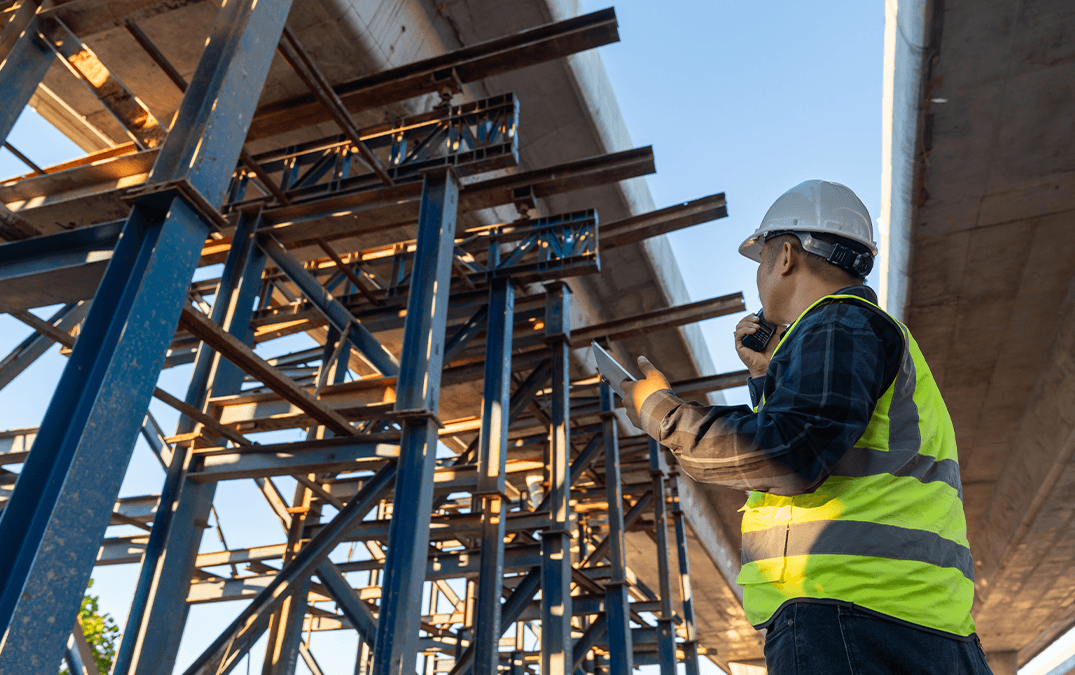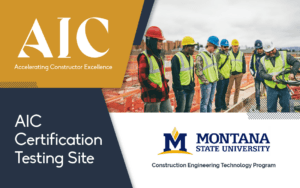It’s no secret that safety is paramount on a construction site. With all the personnel, machinery, and potentially dangerous situations, it’s important to be aware, prepared, and informed on the best ways to remain safe while also completing projects with efficiency and skill.
At the American Institute of Constructors (AIC), we’re committed to creating better working environments one professional at a time. A key method to achieve this goal is by creating, reviewing, and refining your construction company safety plan.
Let’s review the importance of constantly focusing on your plan so that you can build the right company culture where safety is a top priority.
Why Focus on the Construction Company Safety Plan?
Construction managers serve a vital role in keeping everyone out of harm’s way in the day-to-day operations on the job site. Creating a company safety plan is beneficial for these reasons:
- Helps organize and educate workers on proper protocols and procedures.
- Reduces the risk of panic in times of high stress.
- Allows for more conscious decision-making before an accident occurs.
- Promotes increased credibility within the construction industry itself.
Knowing the principles of safety management, the techniques that work, and the strategies necessary to improve safety on the job site are integral to a construction manager’s role within the company. A safe site is a productive site, so thinking ahead and establishing a plan will reward you in the future.
Remember that people are your most important asset. So, creating a system of assessment, feedback, and preparedness will help construction workers be part of the solution to support construction site safety and health.
Why Put Forth the Effort to Make a Plan?
For safety to improve, managers must prioritize proactive thinking, training programs, and regular assessments. According to Dan Petersen’s book, Safety by Objectives: What Gets Measured and Rewarded Gets Done, the following strategies will lead to high success rates:
- Progress should not be measured by accident rates
- Safety should become an embedded system that is continuously evaluated and improved upon
- Transparent reporting and “whistle-blowers” are encouraged to keep everyone accountable
- Employees are involved in the problem-solving and decision-making related to safety protocols
- Gimmicks and slogans are eliminated in favor of actual action and quantifiable results
- Blame is eliminated and replaced with education and support
- Accident investigations are eliminated or reformed to fix systemic problems instead of accusing or punishing those involved in a workplace safety violation or incident
Instilling these basics into your company culture will show your strength as a construction manager and also improve the experiences of workers, clients, and the company as a whole.
The Building Blocks of a Good Construction Safety Plan
But what does a good plan look like? Each company and manager will approach things differently depending on their situation, but there are a few basic points that should be the hallmarks of an effective plan that permeates the entire culture.
1. Management Commitment and Leadership
First, the company should clearly state their commitment to safety at all levels. Then, they need to appoint a dedicated safety officer or team that will look after all matters related to the safety plan.
2. Hazard Identification and Assessment
Each job should be assessed for potential hazards and dealt with accordingly. Materials, equipment, and processes should all be noted with their corresponding hazards so that everyone is on the same page and can work as a team. Any safety hazards should be publicly identified and mitigated.
3. Employee Training and Education
A comprehensive training program is the best way to stop accidents before they start. All current employees should be adequately trained on the plan, and new hires should be provided with additional training.
Educational topics should include hazard recognition, proper use of PPE, and safety and emergency response procedures in accordance with established guidelines.
4. Safety Procedures, Policies, and Tools
Develop and document safety policies and procedures that are straightforward and clear. There should be established protocols for reporting everything from safety concerns to near-misses to full-blown incidents.
These policies should be updated as needed with proper communication of changes given to all employees. Likewise, necessary safety equipment and tools should be provided for workers. This equipment should be regularly inspected and maintained.
5. Emergency Response Plans
Before an emergency occurs, a plan should be in place to mitigate safety concerns. Communicating a plan of action for scenarios like fire, accidents, and natural disasters is key to keeping things under control.
Regular drills and training exercises will make sure employees are familiar with the proper procedures. Also, make sure everyone on the job site is aware of emergency contact information.
6. Safety Inspections & Incident Reporting
The work site conditions should be routinely inspected, and any deficiencies should be promptly noted and addressed. By involving workers in this inspection process, you can encourage safety awareness.
When incidents or near-misses occur, there should be a clear process for reporting them. These reports should lead to investigations that find the root causes and fix them rather than trying to establish blame on an individual.
7. Compliance
Stay current with all local, state, and federal safety regulations to incorporate this information into your safety plan for construction. By ensuring compliance with all relevant safety standards and requirements, you’ll stay one step ahead of incidents.
8. Incentives & Recognition
Implement a program that rewards safe behaviors! By recognizing and celebrating safety milestones and achievements (whether by individuals or the company as a whole), you’ll boost morale and instill better safety values in all.
Achieve Desired Results with a Construction Company Safety Plan
Writing a construction safety plan shows that safety is a top priority. Showing your employees that their health and well-being are at the top of the company’s list creates a better working environment that will result in higher retention rates, improved morale, and higher-quality projects. Taking action can also help with risk management by addressing OSHA safety concerns head-on.
We know that constructors are working hard to make sure these risks are minimized. One way to help is to spread the word about safety within your own company, especially to reach the next generation of managers.
Investing in construction safety will help instill the next generation of construction professionals with a similar ethos, helping everyone in the industry flourish for decades to follow.
Join AIC to Strengthen Your Safety Culture
Want to know more about safety, ethics, and being an effective construction manager? Get involved with AIC as an individual member or partner company.
By joining AIC, you can help elevate the conversation around construction safety and share your insights on how to create a construction company safety plan that supports the culture.




